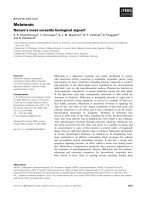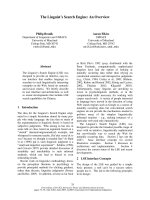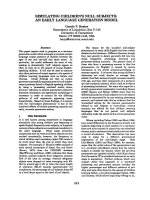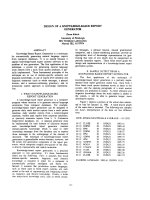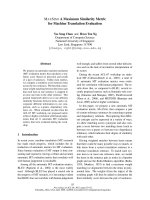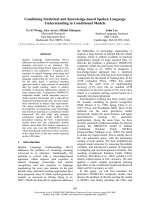Báo cáo khoa học: "CL Research’s Knowledge Management System" pdf
Bạn đang xem bản rút gọn của tài liệu. Xem và tải ngay bản đầy đủ của tài liệu tại đây (109.03 KB, 4 trang )
Proceedings of the ACL Interactive Poster and Demonstration Sessions,
pages 13–16, Ann Arbor, June 2005.
c
2005 Association for Computational Linguistics
CL Research’s Knowledge Management System
Kenneth C. Litkowski
CL Research
9208 Gue Road
Damascus, MD 20872
Abstract
CL Research began experimenting with
massive XML tagging of texts to answer
questions in TREC 2002. In DUC 2003, the
experiments were extended into text
summarization. Based on these experiments,
The Knowledge Management System (KMS)
was developed to combine these two
capabilities and to serve as a unified basis for
other types of document exploration. KMS has
been extended to include web question
answering, both general and topic-based
summarization, information extraction, and
document exploration. The document
exploration functionality includes identification
of semantically similar concepts and dynamic
ontology creation. As development of KMS has
continued, user modeling has become a key
research issue: how will different users want to
use the information they identify.
1 Introduction
In participating the TREC question-answering track,
CL Research began by parsing full documents and
developing databases consisting of semantic relation
triples (Litkowski, 1999). The database approach
proved to be quite confining, with time requirements
expanding exponentially trying to maintain larger sets
of documents and increasingly complex procedures to
answer questions. A suggestion was made to tag text
with the type of questions they could answer (e.g.,
tagging time phrases as answering when questions
and person names as answering who questions). This
led to the general approach of analyzing parse trees to
construct an XML representation of texts (i.e.,
attaching metadata to the text) and examining these
representations with XPath expressions to answer
questions.
Litkowski (2003a) demonstrated the viability of
this approach by showing that XPath expressions
could be used to answer questions at a level above the
highest performing team. Many issues and problems
were identified: (1) The necessary level of analysis to
meet the needs of particular applications; (2) tagging
alternatives; and (3) the viability of the using the
XML representation for text summarization,
information extraction, novelty detection, and text
mining. Subsequent efforts showed that XML
representations could be effectively used in
summarization (Litkowski, 2003b) and novelty
detection (Litkowski, 2005).
Initially, CL Research developed an interface for
examining question-answering performance. This
interface has since evolved into a Knowledge
Management System (KMS) that provides a single
platform for examining English documents (e.g.,
newswire and research papers) and for generating
different types of output (e.g., answers to questions,
summaries, and document ontologies), also in XML
representations. In this demonstration, CL Research
will describe many parts of KMS, particularly the
approaches used for analyzing texts.
1
The
demonstration will particularly focus on the value of
XML in providing a flexible and extensible
mechanism for implementing the various NLP
functionalities. In addition, the demonstration will
identify the emerging issue of user modeling to
determine exactly how knowledge will be used, since
1
Screen shots of KMS in performing the
functions as described below are can be seen at
/>13
the primary purpose of KMS is to serve as a tool that
will enable users (such as scientists and intelligence
analysts) to accumulate and manage knowledge
(including facts, such as described in Fiszman et al.,
2003) about topics of interest.
2
2 Parsing and Creation of XML Tagging
KMS and each of its application areas is based on
parsing text and then transforming parse trees into an
XML representation. CL Research uses the Proximity
Parser, developed by an inventor of top-down syntax-
directed parsing (Irons, 1961).
3
The parser output
consists of bracketed parse trees, with leaf nodes
describing the part of speech and lexical entry for
each sentence word. Annotations, such as number and
tense information, may be included at any node.
(Litkowski (2002) and references therein provide
more details on the parser.)
After each sentence is parsed, its parse tree is
traversed in a depth-first recursive function. During
this traversal, each non-terminal and terminal node is
analyzed to identify discourse segments (sentences
and clauses), noun phrases, verbs, adjectives, and
prepositional phrases. These items are maintained in
lists; the growing lists constitute a document’s
discourse structure and are used, e.g., in resolving
anaphora and establishing coreferents (implementing
techniques inspired by Marcu (2000) and Tetreault
(2001)). As these items are identified, they are
subjected to a considerable amount of analysis to
characterize them syntactically and semantically. The
analysis includes word-sense disambiguation of
nouns, verbs (including subcategorization
identification), and adjectives and semantic analysis
of prepositions to establish their semantic roles (such
as described in Gildea & Jurafsky, 2002).
When all sentences of a document have been
parsed and components identified and analyzed, the
various lists are used to generate the XML
representation. Most of the properties of the
components are used as the basis for establishing
XML attributes and values in the final representation.
(Litkowski 2003a provides further details on this
process.) This representation then becomes the basis
for question answering, summarization, information
extraction, and document exploration.
The utility of the XML representation does not
stem from an ability to use XML manipulation
technologies, such as XSLT and XQuery. In fact,
these technologies seem to involve too much
overhead. Instead, the utility arises within a
Windows-based C++ development environment with
a set of XML functions that facilitate working with
node sets from a document’s XML tree.
3 Question Answering
As indicated above, the initial implementation of the
question-answering component of KMS was designed
primarily to determine if suitable XPath expressions
could be created for answering questions. CL
Research’s XML Analyzer was developed for this
purpose.
4
XML Analyzer is constructed in a C++
Windows development environment to which a
capability for examining XML nodes has been added.
With this capability, a document can be loaded with
one instruction and an XPath expression can be
applied against this document in one more instruction
to obtain a set of nodes which can be examined in
more detail. Crucially, this enables low-level control
over subsequent analysis steps (e.g., examining the
text of a node with Perl regular expressions).
XML Analyzer first loads an XML file (which
can include many documents, such as the “top 50”
used in TREC). The user then presents an XPath
expression and discourse components (typically, noun
phrases) satisfying that expression are returned. XML
Analyzer includes the document number, the sentence
number, and the full sentence for each noun phrase.
Several other features were added to XML Analyzer
to examine characteristics of the documents and
sentences (particularly to identify why an answer
2
The overall design of KMS is based on
requirements enunciated by intelligence analysts and
question-answering researchers in a workshop on
Scenario-Based Question Answering sponsored by the
Advanced Research and Development Agency in 2003.
3
An online demonstration of the parser is
available at A demo
version of the parser is available for download at
/>4
A demo version of XML Analyzer is available
for download at />14
wasn’t retrieved by an XPath expression).
XML Analyzer does not include the automatic
creation of an XPath expression. KMS was created
for TREC 2003 as the initial implementation of a
complete question-answering system. In KMS, the
question itself is parsed and transformed into an
XML representation (using the same underlying
functionality for processing documents) and then used
to construct an XPath expression.
An XPath expression consists of two parts. The
first part is a “passage retrieval” component, designed
to retrieve sentences likely to contain the answer. This
basic XPath is then extended for each question type
with additional specifications, e.g., to ask for noun
phrases that have time, location, or other semantic
attributes. Experiments have shown that there is a
tradeoff involved in these specifications. If they are
very exacting, few possible answers are returned.
Backoff strategies are used to return a larger set of
potential answers and to analyze the context of these
potential answers in more detail. The development of
routines for automatic creation of XPath expressions
is an ongoing process, but has begun to yield more
consistent results (Litkowski, 2005).
In preparation for TREC 2004, KMS was further
extended to incorporate a web-based component.
With a check box to indicate whether the web or a
document repository should be used, additional
functionality was used to pose questions to Google. In
web mode, an XML representation of a question is
still developed, but then it is analyzed to present an
optimal query to Google, typically, a pattern that will
provide an answer. This involves the use of an
integrated dictionary, particularly for creating
appropriate inflected forms in the search query. KMS
only uses the first page of Google results, without
going into the source documents, extracting sentences
from the Google results and using these as the
documents. (A user can create a new “document
repository” consisting of the documents from which
answers have been obtained.) Many additional
possibilities have emerged from initial explorations in
using web-based question answering.
4 Summarization
Litkowski (2003a) indicated the possibility that the
XML representation of documents could be used for
summarization. To investigate this possibility, XML
Analyzer was extended to include summarization
capabilities for both general and topic-based
summaries, including headline and keyword
generation. Summarization techniques crucially take
into account anaphora, coreferent, and definite noun
phrase resolutions. As intimated in the analysis of the
parse output, the XML representation for a referring
expression is tagged with antecedent information,
including both an identifying number and the full text
of the antecedent. As a result, in examining a
sentence, it is possible to consider the import of all its
antecedents, instead of simply the surface form.
At the present time, only extractive
summarization is performed in KMS. The basis for
identifying important sentences is simply a frequency
count of its words, but using antecedents instead of
referring expressions. Stopwords and some other
items are eliminated from this count.
In KMS, the user has the option for creating
several kinds of summaries. The user specifies the
type of summary (general, topic-based, headline, or
keyword), which documents to summarize (one or
many), and the length. Topic-based summaries
require the user to enter search terms. The search
terms can be as simple as a person’s name or a few
keywords or can be several sentences in length.
Topic-based summaries use the search terms to give
extra weight to sentences containing the search terms.
Sentences are also evaluated for their novelty, with
redundancy and overlap measures based on
examining their noun phrases. KMS summarization
procedures are described in more detail in Litkowski
(2003b); novelty techniques are described in
Litkowski (2005).
In KMS, summaries are saved in XML files as
sets of sentences, each characterized by its source and
sentence number. Each summary uses XML
attributes containing the user’s specifications and the
documents included in the search. generated quickly
but in whole form.
5 Document Exploration
KMS includes two major components for
exploring the contents of a document. The first is
based on the semantic types attached to nouns and
verbs. The second is based on analyzing noun phrases
to construct a document hierarchy or ontology.
As noted above, each noun phrase and each verb
15
is tagged with its semantic class, based on WordNet.
A user can explore one or more documents in three
stages. First, a semantic category is specified.
Second, the user pushes a button to obtain all the
instances in the documents in that category. The
phraseology in the documents is examined so that
similar words (e.g., plurals and singulars and/or
synonyms) are grouped together and then presented in
a drop-down box by frequency. Finally, the user can
select any term set and obtain all the sentences in the
documents containing any of the terms.
KMS provides the capability for viewing a
“dynamic” noun ontology of a document set. All noun
phrases are analyzed into groups in a tree structure
that portrays the ontology that is instantiated by these
phrases. Noun phrases are reduced to their base
forms (in cases of plurals) and grouped together first
on the basis of their heads. Synonym sets are then
generated and a further grouping is made. Algorithms
from Navigli & Velardi (2004) are being modified
and implemented in KMS. The user can then select a
node in the ontology hierarchy and create a summary
based on sentences containing any of its terms or
children.
6 Dictionaries and Thesauruses in KMS
KMS makes extensive use of integrated dictionaries
and thesauruses, in addition to a comprehensive
dictionary used in parsing (which makes use of about
30 subcategorization patterns for verbs). This
dictionary is supplemented with other dictionaries that
are first used in dynamically extending the parser’s
dictionary for parsing, but then more extensively in
semantic analysis. WordNet is used for many
functions, as is a Roget-style thesaurus. KMS also
uses a full machine-readable dictionary, dictionaries
and semantic networks from the Unified Medical
Language System, and a specially constructed
dictionary of prepositions for semantic role analysis.
7 Summary
The preceding sections have focused on particular
prominent functionalities (question-answering,
summarization, and document exploration) in KMS.
Each of these components is part of the whole, in
which the main objective is to allow a user to explore
documents in a variety of ways to identify salient
portions of one or more documents. KMS is designed
to identify relevant documents, to build a repository
of these documents, to explore the documents, and to
extract relevant pieces of information.
References
Fiszman, M., Rindflesch, T., & Kilicoglu, H. (2003).
Integrating a Hypernymic Proposition Interpreter
into a Semantic Processor for Biomedical Texts.
Proceedings of the AMIA Annual Symposium on
Medical Informatics.
Gildea, Daniel, and Daniel Jurafsky. (2002) Automatic
Labeling of Semantic Roles. Computational
Linguistics, 28 (3), 245-288.
Irons, E. T. (1961) A Syntax Directed Compiler for
ALGOL-60. Communications of the ACM, 4, 51-
55.
Litkowski, K. C. (1999). Question Answering Using
Semantic Relation Triples. In E. M. Voorhees &
D. K. Harman (eds.), The Eighth Text Retrieval
Conference (TREC-8). NIST Special Publication
500-246. Gaithersburg, MD., 349-56.
Litkowski, K. C. (2002). CL Research Experiments in
TREC-10 Question-Answering. In E. M. Voorhees
& D. K. Harman (eds.), The Tenth Text Retrieval
Conference (TREC 2001). NIST Special
Publication 500-250. Gaithersburg, MD., 122-131.
Litkowski, K. C. (2003a). Question Answering Using
XML-Tagged Documents. In E. M. Voorhees & L.
P. Buckland (eds.), The Eleventh Text Retrieval
Conference (TREC 2002). NIST Special
Publication 500-251. Gaithersburg, MD., 122-131.
Litkowski, K. C. (2003b). Text Summarization Using
XML-Tagged Documents. Available:
/>Litkowski, K. C. (2005). Evolving XML and Dictionary
Strategies for Question Answering and Novelty
Tasks. Available:
/>ml.
Marcu, Daniel. (2000) The Rhetorical Parsing of
Unrestricted Texts: A Surface-based Approach.
Computational Linguistics, 26 (3), 395-448.
Navigli, R. & P. Velardi (2004) Learning Domain
Ontologies from Document Warehouses and
Dedicated Web Sites. Computational Linguistics
30, 151-180.
Tetreault, Joel. (2001) A Corpus-Based Evaluation of
Centering and Pronoun Resolution. Computational
Linguistics, 27 (4), 507-520.
16
